STUDENT’S PERCEPTION ON THE USE OF YOUTUBE AS A LEARNING MEDIA TO IMPROVE THEIR SPEAKING SKILL
Abstract
Abstract: The objective of this research was to investigate the perception of students of English speaking class on using Youtube toward their achievement in speaking skill. The subject of the research was students of English department of Bengkulu University who took Speaking 2 class with 40 students in total. Questionnaire and short interview were used as the way to collect the data. The questionnaire then, was analyzed by using Likert scale while interview data was used to discover new facts/phenomena from the study. The finding generally shows that 1) students consider that the Youtube can help their speaking skill becoming much better.2) The use of Youtube in speaking class also can trigger them to be much confident to speak English in front of camera and public. 3) Feedbacks/comments coming from other students on the Youtube were useful to improve their speaking skill and video’s quality as well. It can be concluded that the use of Youtube as a learning media in speaking class can help students to improve their speaking skill.
Keywords: Perception, Youtube, speaking skill
Full Text:
324-329References
Abrar, M., Mukminin, A., Habibi, A., Asyrafi, F., Makmur, M., & Marzulina, L. (2018). “If our English isn’ta language, what is it?” Indonesian EFL Student Teachers’ Challenges Speaking English. The Qualitative Report, 23(1), 129-145.
Burke, S. C., & Snyder, S. L. (2008). YouTube: An Innovative Learning Resource for College Health Education Courses. International Electronic Journal of Health Education, 11, 39-46.
Clifton, A., & Mann, C. (2011). Can YouTube enhance student nurse learning?. Nurse education today, 31(4), 311-313.
Duffy, P. (2008). Engaging the YouTube Google-eyed generation: Strategies for using Web 2.0 in teaching and learning. Electronic Journal of E-learning, 6(2), 119-130.
Fralinger, B., & Owens, R. (2009). YouTube as a learning tool. Journal of College Teaching & Learning, 6(8), 15-28
Jaffar, A. A. (2012). YouTube: An emerging tool in anatomy education. Anatomical sciences education, 5(3), 158-164.
Kurniawan, I., Syafrizal, S., & Fernandita, G. J. (2018). An Analysis Of Students’english Speaking Skills At Coastal Schools Of Bengkulu City, Indonesia. The Journal of English Language Studies, 3(1), 19-31.
Leong, L. M., & Ahmadi, S. M. (2017). An analysis of factors influencing learners’ English speaking skill. International Journal of Research in English Education, 2(1), 34-41.
Orús, C., Barlés, M. J., Belanche, D., Casaló, L., Fraj, E., & Gurrea, R. (2016). The effects of learner-generated videos for YouTube on learning outcomes and satisfaction. Computers & Education, 95, 254-269.
Shadiev, R., Hwang, W. Y., & Liu, T. Y. (2018). Investigating the effectiveness of a learning activity supported by a mobile multimedia learning system to enhance autonomous EFL learning in authentic contexts. Educational Technology Research and Development, 66(4), 893-912.
Article Metrics
Abstract view : 4258 times324-329 - 6939 times
Refbacks
- There are currently no refbacks.
